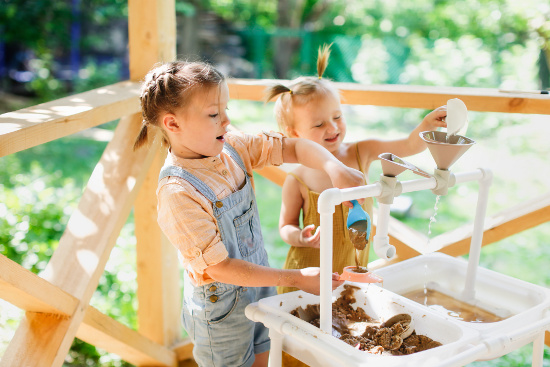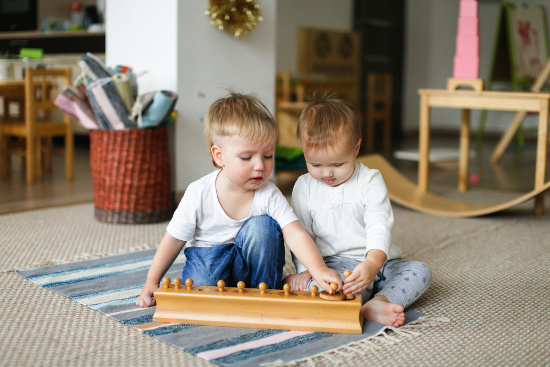Toddlers explore the world primarily through their senses. Touch, taste, sight, smell, and hearing lay the foundation for how they perceive and interact with their surroundings.
Sensory play, which involves activities that stimulate one or more senses, is pivotal in refining these perceptions. Through these playful encounters, toddlers can better grasp the world, fostering cognitive development and enhancing motor skills.


Brookvale Preschool and many early childhood education experts understand that a holistic approach to child development must prioritize sensory experiences. Children exposed to varied sensory stimuli develop an enriched neural network, bolstering their problem-solving capabilities, creativity, and physical coordination.
Cognitive Development
Every sensory experience presents a learning opportunity for toddlers. For example, playing with sand or water allows them to understand concepts of volume, weight, and texture. They can make connections and predictions by experimenting with how sand feels when wet versus when dry.
Providing diverse sensory materials to young learners is essential. Simple activities like matching textures or colors sharpen their memory and observational skills. Furthermore, exposing them to unexpected or unfamiliar sensations teaches them flexibility and adaptability in their thought processes.
In addition, problem-solving skills are enhanced when children face challenges during sensory play. Figuring out how to build a stable sandcastle or discovering the cause and effect of mixing colors deepens their analytical skills.
Fine Motor Skills Enhancement
Manipulating small objects, such as beads, play dough, or rice grains, directly strengthens a child’s fine motor skills. Grasping, pinching, and sorting these items require precision, control, and coordination between the eyes and hands.
Activities like threading beads or molding shapes out of dough are fun and beneficial for their future writing skills. Such exercises enhance hand strength, dexterity, and finger agility, essential for holding a pencil or maneuvering objects carefully.
Moreover, integrating sensory play into daily activities encourages children to use and develop their muscles. Over time, this consistent engagement translates to more refined motor abilities.
Language Development
While it might not be immediately apparent, sensory play offers numerous opportunities for language development. As toddlers explore, they begin describing their experiences, expanding their vocabulary. Terms like ‘rough,’ ‘smooth,’ ‘cold,’ or ‘warm’ are better understood when experienced firsthand.
Engaging with sensory materials also prompts questions and conversations. Adults can guide children by asking open-ended questions like, ‘What does that feel like?’ or ‘What happens when you do that?’ This encourages the child to think critically and articulate their observations.
Incorporating sensory play in institutions also provides a context for introducing new words and concepts. By integrating story time or thematic activities with sensory materials, educators can further enrich a child’s linguistic experience.


Creativity And Imagination
Sensory play is an open-ended experience. There are no specific rules or outcomes, giving children the freedom to create, experiment, and imagine. This unrestricted environment is where their creativity thrives.
Offering a variety of materials allows toddlers to combine and recombine elements in novel ways. Whether it’s creating an imaginary world in a sandbox or concocting a potion with colored water, the possibilities are limitless.
Additionally, sensory play’s tactile and immersive nature can inspire deeper imaginative play. The textures, scents, and sounds can trigger narratives, stories, and role-playing scenarios, enhancing their imaginative capacities.
Social And Emotional Growth
Sensory play isn’t just about individual exploration; it’s also a platform for social interaction. Sharing materials, taking turns, and working collaboratively on projects teach toddlers essential interpersonal skills.
When children play together in a sensory-rich environment, they communicate their ideas, express their feelings, and negotiate roles. They also develop empathy by observing and responding to their peers’ reactions to different stimuli.
Furthermore, sensory play can be therapeutic. For toddlers who may be overwhelmed by certain stimuli, gradual exposure to a controlled and playful environment can help them process and manage their emotions.
Safety And Risk Assessment
While sensory play offers a multitude of developmental benefits, ensuring child safety during these activities is paramount. This involves evaluating the materials used, the environment, and potential risks.
Child-safe materials, free from toxins and small parts that could be choking hazards, are vital. It’s essential to frequently inspect sensory play items for wear and tear to prevent any inadvertent ingestion or injury. Activities involving water or other liquids must be supervised to avoid potential risks of slipping or drowning.
Moreover, sensory play teaches toddlers about personal boundaries and spatial awareness. By navigating different terrains, materials, and interactions, they learn to judge distances, evaluate risks, and understand their physical capabilities, preparing them for the broader world outside.
The Bottom Line
Sensory play is more than just a fun diversion for toddlers. It’s essential to their developmental journey, supporting cognitive growth, motor skills, emotional and social development, language acquisition, and creative expression.
Understanding and promoting these sensory experiences’ importance ensures a well-rounded foundation for every child’s future learning and growth.


























